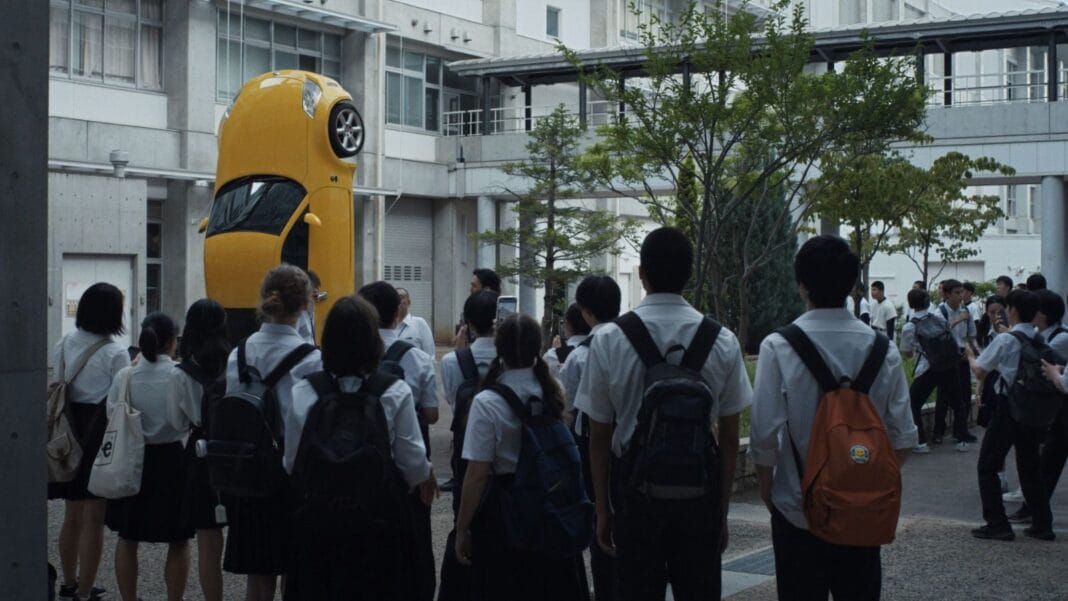Captivating Dystopian Tale: Happyend Movie Review
In the futuristic Tokyo of Neo Sora’s “Happyend,” two high-school friends navigate a city under authoritarian control, where rebellion and surveillance collide. The film’s exploration of power dynamics, urban emptiness, and postapocalyptic anxiety offers a thought-provoking narrative that resonates with current societal concerns. Let’s delve deeper into this cinematic masterpiece.
Happyend Review
“Happyend” follows Yuta and Kou as they rebel against the oppressive forces in their society by reclaiming a hidden nightclub space in a deserted Tokyo. The film cleverly parallels the boys’ coming-of-age story with the larger political landscape, highlighting themes of control, resistance, and the impact of crises on urban life.
The juxtaposition of the desolate cityscape with the characters’ quest for freedom creates a tense atmosphere that underscores the film’s central message. As Yuta and Kou navigate the empty streets, the looming presence of authority and surveillance serves as a constant reminder of the fragile balance between individual agency and state control.
Through its exploration of technology as a tool for manipulation and social control, “Happyend” paints a chilling portrait of a society where personal freedoms are sacrificed in the name of safety. The film’s smart city setting and postapocalyptic undertones add layers of complexity to the narrative, inviting viewers to reflect on the implications of unchecked power and technological advancement.
bluish: A Tale of Urban Isolation
In contrast to the stark urban landscape of “Happyend,” “bluish” offers a more introspective look at urban life in Vienna through the eyes of two young women navigating a post-pandemic world. The film’s exploration of loneliness, connection, and the search for meaning in a digital age adds a poignant layer to its narrative, capturing the essence of contemporary urban existence.
As the protagonists grapple with feelings of isolation and yearning for human connection, “bluish” highlights the nuances of social interaction and the impact of technology on our daily lives. The film’s emphasis on small moments of intimacy and vulnerability serves as a powerful reminder of the enduring need for human connection in an increasingly digital world.
Conclusion
“Happyend” and “bluish” offer compelling narratives that delve into the complexities of urban life, power dynamics, and societal shifts in a rapidly changing world. Through their thought-provoking storytelling and nuanced character development, both films provide audiences with a captivating exploration of human experiences in the face of adversity.
FAQs
1. What is the central premise of “Happyend”?
“Happyend” follows two high-school friends, Yuta and Kou, as they rebel against authoritarian control in a futuristic Tokyo by reclaiming a hidden nightclub space.
2. How does “bluish” explore the theme of urban isolation?
“bluish” delves into the experiences of two young women in Vienna navigating feelings of loneliness, connection, and the search for meaning in a post-pandemic world.
3. What role does technology play in “Happyend” and “bluish”?
Both films examine the impact of technology on society, highlighting its role in surveillance, control, and human interaction in urban environments.
4. How do the characters in “bluish” navigate social connections?
The protagonists in “bluish” explore opportunities for human connection through small gestures of intimacy, vulnerability, and shared experiences in public spaces.
5. What themes are central to the narratives of “Happyend” and “bluish”?
Both films explore themes of resistance, power dynamics, urban emptiness, and the enduring need for human connection in the face of societal challenges.
6. How do the settings of Tokyo and Vienna contribute to the atmosphere of the films?
The futuristic Tokyo of “Happyend” and the post-pandemic Vienna of “bluish” create distinct backdrops that enhance the narratives and reflect the characters’ experiences.
7. What visual motifs are present in “Happyend” and “bluish”?
Both films use visual elements such as lighting, color schemes, and urban landscapes to convey mood, atmosphere, and thematic depth throughout the storytelling.
8. How do the characters in “Happyend” and “bluish” navigate societal challenges?
The characters in both films confront societal norms, power structures, and personal struggles as they seek to assert their agency, forge connections, and navigate the complexities of urban life.
9. What social commentary do “Happyend” and “bluish” offer?
Through their narratives, both films provide insightful commentary on authoritarianism, surveillance, technological control, and the enduring human need for connection, resistance, and agency.
10. How do “Happyend” and “bluish” resonate with contemporary societal issues?
The themes, characters, and narratives of both films offer a reflection of current societal concerns, technological advancements, urban dynamics, and human experiences in a rapidly changing world.

